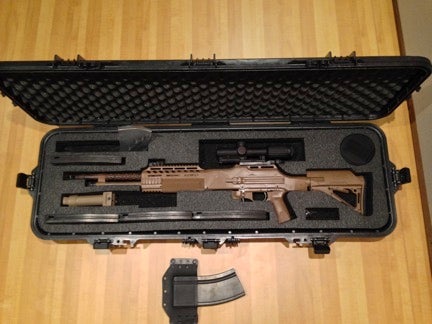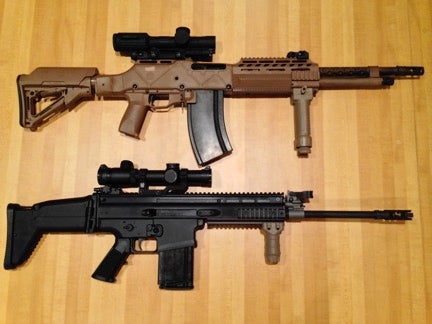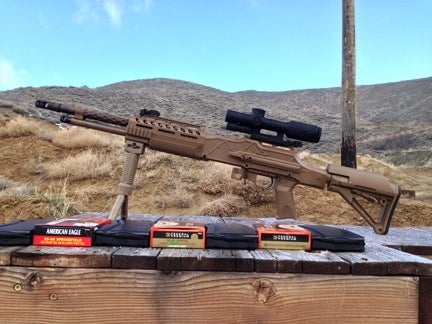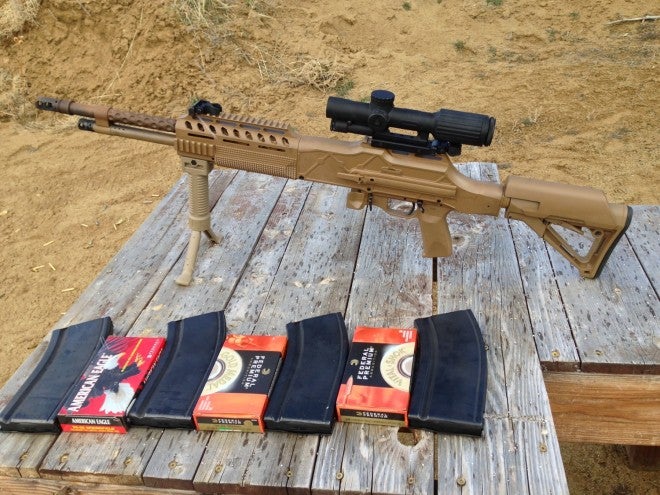[ Steve says: This is a guest post written by Jagersmith ]
In May of 2014, I received a long-awaited email: HCAR’s were finally available to order. The first edition package was impressive, with a choice of 4 colors (at no extra cost), hard case, custom or standard serial number, cleaning kit, owner’s manual, Kydex mag holder, 4 30 round BAR magazines, detachable flip-up iron sights, 100 rounds of ammo, free shipping, and access to an owner’s website with direct customer support from OOW. I got in line immediately, though in several years of gunsmithing and working in FFLs, I knew not to get impatient. Firearms, especially new ones, can have absurdly long “out times”. As far as the firearms industry goes, however, I did not have to wait long, as my rifle was packed and ready to go by late November.

HCAR in case, Mag holder at bottom of picture.
Earlier on, OOW had estimated a ship date of between September and October, and for a mere one-month delay, they threw in an extra magazine and 100 more rounds of free ammo.I regarded that as excellent customer service. The manual is without a doubt one the clearest, most detailed, most well laid out manuals I have yet to read. It even has a section that details, step by step with computer generated cutaway images, the HCAR’s principals of operation and firing cycle. The hardcase also showed attention to detail, with pre-cut sections of foam that could be removed if you added on an optic or bipod. Enough about the extras, though, let’s get to the gun.
I got my HCAR done in coyote tan Cerakote, and it looks fantastic. There was no chipping or overspray of the process anywhere. The gun handles well, and the more than 7-lb trim from the BAR makes it balance well even when shouldered offhand. The rifle itself, sans optic, magazine, or bipod is 11.75 lbs. My fully loaded weight was 16 lbs with the VCOG and grip-pod. My first range outing with the gun was in a pretty heavy snowstorm, so I would not have the opportunity to zero the irons or the optic. Instead, I focused on perceived recoil and handling. This is one soft-shooting .30-06. The hydraulic buffer assembly that fits between the receiver and receiver extension does wonders to dampen recoil to the cheek and shoulder, while the supplied surefire brake keeps the muzzle fairly well on target shot-to-shot, even during rapid strings of fire. The rifle is threaded 5/8-24 if you wish to use a thread-on suppressor or a different brake. The single-stage trigger pull was crisp and clean at an average of 6.6 pounds, with a positive reset. The 2-position safety easily and positively locks into place. “Safe” is in-line with the barrel, “fire” is downward at a 45-degree angle. The magazines drop free when the paddle-style magazine release is operated. The bolt is one of my favorite features, as it locks back on an empty magazine, or when you simply pull back on the charging handle when the gun is unloaded, making chamber inspection or quick cleaning easy. This is a nice feature to have when making the range cold for posting and checking targets. The charging handle is of the folding, non-reciprocating variety. I used the medium gas setting, which is recommended for normal use, though you can easily change to low for suppressed use, or high for an “excessively” dirty rifle by simply rotating the selector at the end of the gas tube.

HCAR vs. SCAR size comparison
I fired through 100 rounds of Greek surplus ammunition, without a single failure to feed, fire, or extract from the magazine. The only issue I did notice was that when inserting a fully loaded 30 round magazine into the receiver with the bolt closed, the first round chambered was slow to go into battery. Ohio Ordnance notes this, however, recommending downloading magazines by 2 rounds if one wishes to load with the bolt closed. They recommend primarily inserting the magazine with the bolt open, then chambering a round using the bolt release.
During my second outing, I still only had access to surplus Greek ammo, though I performed a rough zero of my iron sights and a Trijicon VCOG. When zeroed, I was able to shoot 2-inch groups at 100 yards with both the irons and the 1-6 power VCOG supported off a bench by a grip-pod. I suspect this was due to the ammo and the fact that the VCOG’s dot is 2 MOA in size, as the gun is capable of better accuracy than that. I fired through an additional 100 rounds with no malfunctions. One potential issue I noticed was that the 30-round magazine, at 8.8 inches long, barely clears the ground when the grip pod supports the gun with the barrel parallel to the ground. This is something to consider when possibly engaging elevated targets or firing from defilade, where 20-rounders would give more clearance.
On the third range outing, I had not yet performed a detailed cleaning of the gun, as I was curious how many rounds I could fire before it started malfunctioning. Having received a shipment of Federal Premium 168-grain Sierra Matchking BTHP, 180 grain Trophy Copper, and American Eagle 150-grain FMJBT, I had much better ammunition available to me this time. It was finally time to test the accuracy potential. The 1/10 RH twist barrel performed best with the Matchkings, turning in an outstanding 5 shot group of .55 inches without the one flyer, 1.16 inches flyer included. This was using a 2 MOA dot at 6x with a support of the grip-pod off a bench. The Trophy Coppers turned in a 1.5 inch group, and the American Eagles a 1.7 inch. All groups were smaller than the dot, so I was very pleased with the accuracy. During accuracy testing, however, I did start to experience malfunctions. These started to occur after firing all 200 rounds of the Greek HXP ammunition and cleaning nothing but the bore and barrel. The Matchkings started to hang up on the fouled feed ramp, causing the bolt to lock up, on all gas settings and all magazines (I at first thought it might be a magazine or temperature issue). Either charging the bolt handle or holding down the bolt release button easily cleared malfunctions. Due to the fouling, I noticed some scraping on the tip of the rounds. The American Eagle rounds experienced this as well on all gas settings. The Trophy Coppers did not. I should note that OOW recommends using mil-spec rounds (150 grain FMJ) in the HCAR Later on, after a good and thorough cleaning, the action was cycling as usual. Once I established accuracy on paper, I moved to a 1/3-size silhouette at 140 yards, hitting it easily and repeatedly. I then moved to a 220-yard plate, ringing it without issue. Finally, I was able to get both my 1st and subsequent hits on the 500 yard plate repeatedly without effort, as the weight of the gun and the hydraulic buffer allowed me to watch my impacts hit. I came away very impressed at the accuracy of the HCAR, as well as its ergonomics (I am right handed) and ease of use.

Ready for accuracy testing

Best group of the day, .55 inches at 100 yards w/o the flyer, 1.16 width.
Disassembly for cleaning
Basic disassembly for maintenance is a bit more involved than your average AR or AK. It is an 11-step process.
- Remove the magazine, inspect the chamber, allow the bolt to go forward.
- Push trigger group takedown pins out, remove trigger group.
- Push gas tube takedown pin out until locked, remove gas tube assembly and handguard.
- Remove driving rod and spring from receiver
- With slide in forward position, use hook tool to remove bolt guide spring and then bolt guide.
- Move slide in, push out pin, remove charging handle assembly,
- Remove cocking insert from slide, and slide from receiver.
- Lift bolt tail from receiver, move bolt rearward and lift from receiver.
- Remove bolt link pin.
- Remove gas regulator pin using a punch.
- Remove locking key from gas tube, and unscrew gas regulator.
As one can see, it is a very detailed disassembly and requires tools to remove the bolt. I have found that practical cleaning at the range is best performed by simply locking the bolt back and then using a boresnake for the barrel and a brush for the bolt head.
Final impression
The HCAR is a very stable, accurate, ergonomically friendly weapon, with an added bonus of using surplus M1918 BAR magazines and the ability to accept any AR-15 buttstock. The patented multi stage firing pin system is an appreciated safety feature. I would have liked them to keep the adjustable trigger as a feature; the pre-production models had them. It also needs to be cleaned very regularly, and evidenced by the malfunctions experienced after 200 rounds. I suspect polishing the feed ramp will help ameliorate this issue some. It’s disassembly process, though lengthy, was not overly difficult, but was much more involved than an AR or AK. It is a heavy rifle, but much lighter than a standard M1918 BAR. Should it be your all-in-one rifle? No. Does it have a place in a well-rounded collection of firearms, and is it extremely well made? Yes. Overall, I am very happy with my purchase.
 Your Privacy Choices
Your Privacy Choices
